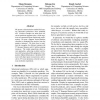Free Online Productivity Tools
i2Speak
i2Symbol
i2OCR
iTex2Img
iWeb2Print
iWeb2Shot
i2Type
iPdf2Split
iPdf2Merge
i2Bopomofo
i2Arabic
i2Style
i2Image
i2PDF
iLatex2Rtf
Sci2ools
EMNLP
2008
2008
Discriminative Learning of Selectional Preference from Unlabeled Text
We present a discriminative method for learning selectional preferences from unlabeled text. Positive examples are taken from observed predicate-argument pairs, while negatives are constructed from unobserved combinations. We train a Support Vector Machine classifier to distinguish the positive from the negative instances. We show how to partition the examples for efficient training with 57 thousand features and 6.5 million training instances. The model outperforms other recent approaches, achieving excellent correlation with human plausibility judgments. Compared to Mutual Information, it identifies 66% more verb-object pairs in unseen text, and resolves 37% more pronouns correctly in a pronoun resolution experiment.
EMNLP 2008 | Human Plausibility Judgments | Natural Language Processing | Observed Predicate-argument Pairs | Vector Machine Classifier |
| Added | 29 Oct 2010 |
| Updated | 29 Oct 2010 |
| Type | Conference |
| Year | 2008 |
| Where | EMNLP |
| Authors | Shane Bergsma, Dekang Lin, Randy Goebel |
Comments (0)

